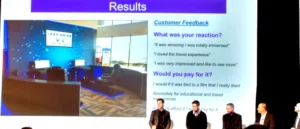As expected, VR was well represented at CinemaCon this year. I was able to attend a seminar on the topic and try out several demos. Almost all the ones I saw featured VR plus some sort of motion platform to create a more theme park ride type of entertainment. These were all three degree of freedom demos which means you can look all around, but you can’t move and explore the space.

In the seminar on VR, Austin Barker from Universal Studios started by saying that he loves the movies and wants to be washed over with emotion when he watches a film. He wants the same thing to happen in VR, but the ways to do this are in their infancy. Games and first person shooter genres are the most popular VR content and an obvious application.
The second category he mentioned was site-based or location-based VR. For this, interaction with the VR environment is the norm today.
The third category is what he terms 360º video where he thinks the New York Times is leading the way. Here, the ability to empathize with the news story seems to be a key driver.
Finally, he said cinematic VR is the fourth type and probably the toughest to produce.
Universal has also developed a new VR experience for the upcoming release of the latest Mummy movie with Tom Cruise. I had a chance to try this at CinemaCon so see separate report (VR Experiences at CinemaCon). They also have a VR project for the upcoming GooseBumps movie.
To move the nascent industry forward, there is a need to attract top writers and directors. A great script is the key element because he feels they have a mature enough workflow now.
Jake Zim of Sony Pictures Entertainment says he wants to create emotional VR that can work on the PlayStation VR or in location-based settings. He said the big challenge they see is how to tell the story in VR and develop new worlds.
He then played some clips showing people engaged in the Ghost Buster site-based VR experience Sony launched at Madame Tussaud’s Museum in New York last summer to coincide with the release of that movie. Admission to the museum is $30 and the VR experience is an additional $20. This has been a big hit and is generating revenue. Attendees wear a backpack and VR headset and carry a “buster”, moving through several rooms.
He also described “The Wire” VR experience about walking on a tight rope between the twin towers in New York. Attendees have to do this in VR. He said that 50% make it through and 50% can’t because it is too terrifying. “That’s how powerful the experience can be,” he said.
Ted Schilowitz of the Fox Innovation Lab said VR is not new and personal experiences are not new, but the current state of VR technology “enables theme parks at any location.” This includes in theater lobbies, which he thinks is a great idea.
He runs the Innovation Lab where Fox is learning how to tell stories in VR. They did a short VR piece to support “Into the Wild” and a second one for the launch of “The Martian”. In development are two VR experiences for the upcoming Alien movie and two for the next Planet of the Apes film.
He noted that the movie business and the game business create lots of content with flops, mid-performers and mega hits. The mega hits drive the industry and he thinks VR developers need to start thinking this way too – create lots of content and hope for a blockbuster.
He also said that theater are perhaps 80% empty and exhibitors should be looking at ways to do something with this mostly dead time – and VR is one answer. “If I want to see a 4 pm movie, maybe I come to the theater a couple of hours early to enjoy the other entertainment there – the side shows if you will, said Schilowitz.
David Campbell of IMax described how they are committed to leading the way in VR by rolling out VR pods at their theaters. They are devoting $50M to the effort and now have the first experience center now operational in LA. Five more are planned for 2017. They are also working with Google to develop a professional grade VR camera system.
He noted that others are doing similar things like the MK2 chain in France and another chain in China.
“VR won’t replace the cinema but we hope it will extend the story with engagement and interaction,” said Campbell.
Kevin Cardullo of National Amusements (NA) described a project they did to evaluate the issue with location-based VR, which ultimately resulted in two installations they are running. He said their team found that each hardware and software platform had its own ecosystem and that there was little commonality between them, which is a long term problem. Plus, the hardware is not really robust enough for commercial use. They looked at the safety issues with tethered headsets and the liability issues and bad PR issue should someone become ill. Currently, there is not enough content for location-based venues.
Nevertheless, NA decided to establish a lab and develop content and two installations. These feature the Oculus rift and two pieces of content they developed. One is a ‘lazy ride down a river’ and the other a robot blowing up things along a road. So far, they have had good reactions and they decided not to try to monetize this now. Getting feedback was more valuable.
In conclusion, Schilowitz predicted that the limitations of the hardware today will be overcome in the short term with “some amazing technology” so content creators and exhibitors should be preparing for the future now. – CC

